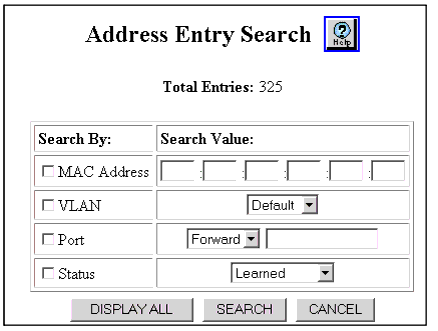|
|
|
To filter the AFT using the Web Agent:
The Address Entry Search Web page is displayed in the content pane. See Figure�81.
Figure�81:�Address Entry Search Web Page

Note: DISPLAY ALL ignores any parameter not checked in the left column. To view all addresses in the table, select DISPLAY ALL without selecting any filters.
Note: You must enter the complete MAC address.
Figure�82:�Address Forwarding Table Web Page

Note: Some types of entries in the Address Forwarding Table can be modified. The port, priority, and persistence can be changed for learned and management entries.
| Parameter |
Description |
|---|---|
| Index |
Index number of this address entry in the switch address forwarding table. |
| MAC Address |
MAC address associated with this entry. This address is learned by the switch as an address to forward to the associated port. |
| Port |
Port associated with this MAC address table entry. |
| Valid |
An entry is valid until it ages out, at which time it becomes invalid. Aging out occurs when a frame with the entry's MAC address is not received during the address age time interval. An invalid entry can become a valid entry again if the entry's MAC address is learned (frame is received) during the super age time interval. If the super age time interval expires before the MAC address is learned again, the entry is deleted." |
| Group |
Group number associated with this MAC address. |
| TblInst |
Address table instance number associated with this MAC address. |
| Priority |
Priority level associated with traffic forwarded to this MAC address. The options are:
You can set this parameter on all learned entries. |
| Persistence |
The persistence of the entry in the table can be set on all learned entries:
Note: If you create a static, filtered MAC address and set Persistence to Ageout, the switch does not filter the MAC address. The switch continues to forward frames that have the MAC address for a source address or destination address. To correct this, set Persistence to Permanent. |
| Status |
The status of the address entry. Options include:
|
|
|
|